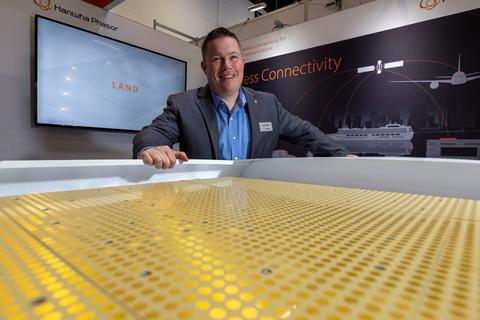Hanwha Phasor is offering a new electronically steered antenna (ESA) to deliver in-flight connectivity to the cabin.
The A7700 marks the first aerospace product from the London-headquartered company, which was established in 2020 by South Korean aerospace and defence firm Hanwha Systems.

Scott McCobb, the company’s director commercial aviation, says the A7700 takes a parabolic dish and flattens it out. “It’s ultra-low profile compared to a parabolic dish and the performance you get is faster speeds and faster transition between beam switching,” he says.
“That’s an advantage with our antenna. It can receive two different beams – from low earth orbit (LEO) satellites, and at the same time from a geosynchronous orbit satellite (GEO), which we believe is unique.
“In essence, what we’re giving you with that aperture is the ability to be operating like two antennas that receive two different things,” McCobb adds.
The Airbus A320 is the initial targeted aircraft for the A7700. As the product then goes to market, Hanwha Phasor will then make another iteration, which will be tailored to the next customer’s needs. At its AIX stand, the company envisages the possibility of use on regional jets. McCobb explains the potential process.
“This ESA has scalable technology. A tile can be scaled up to be as big as the customer wants or as small as the customer wants,” he says.
“Also important to know is that we’re network agnostic, in the sense that we want to work with every service provider out there and be able to offer that flexibility to the end customer where they only have to buy one piece of hardware that will then give them the ability to work or select their end service provider.”
To help bring the A7700 to market, Hanwha Phasor has signed an agreement with Lufthansa Technik for the latter to manufacture the radome for the antenna and to help in attaining a Supplemental Type Certificate (STC). Plexus has been selected to manufacture the antenna and Kontron will tailoring one of its power supply products for the system.
No launch customer has been confirmed as yet, but McCobb is confident of orders in the not too distant future. “Otherwise we won’t be able to complete our STC, if we don’t have a customer already in mind,” he explains. Completion of the STC is expected in the third quarter of 2025, with entry into service shortly after.


























